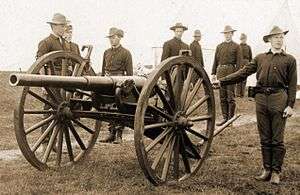3.2-inch gun M1897
| 3.2-inch gun M1897 | |
|---|---|
 Model 1885 with crew, Spanish–American War era. Note the three-stage barrel rather than the two-stage barrel used on the Model 1897. | |
| Type | Light field gun |
| Place of origin | United States |
| Service history | |
| In service | 1885–1919 |
| Used by | US Army |
| Wars | |
| Production history | |
| Designer | Watervliet Arsenal |
| Designed | 1885 |
| Produced | 1885-1899 |
| No. built |
|
| Variants | M1885, M1890, M1897 |
| Specifications | |
| Weight |
830 lb (380 kg) gun & breech; 2,130 lb (970 kg) gun & carriage total[1] |
| Barrel length | 26 calibers, 83.2 inches (2.11 m) (bore)[1] |
|
| |
| Shell |
|
| Calibre | 3.2-inch (81 mm) |
| Breech | Interrupted screw, De Bange type[1] |
| Recoil | wheel brakes, no recoil mechanism[1] |
| Carriage | wheeled |
| Elevation | +20° max |
| Muzzle velocity | 1,685 ft/s (514 m/s) |
| Maximum firing range | 6,530 yd (5,970 m) |
| Feed system | hand |
.jpg)
The 3.2-inch gun M1897 (81 mm), with its predecessors the M1885 and M1890, was the U.S. Army's first steel, rifled, breech loading field gun. It was the Army's primary field artillery piece in the Spanish–American War and the Philippine–American War from 1898 to 1902.[1]
Design
This series of weapons was designed to provide a modern alternative to breechloading conversions of the Civil War-era 3-inch Ordnance rifle. It was made of gun steel, stronger than the wrought iron of previous weapons. It fired a 13.5 lb (6.1 kg) projectile with cast iron, shrapnel, or canister types available.[1] All versions used separately loaded bag charges. The M1885 and M1890 used black powder when first introduced, but the M1897 was redesigned for smokeless powder; the M1890 weapons were then modified for smokeless powder and redesignated M1897s.[1][2] In the Spanish–American War, difficulties were encountered in ramping up production of smokeless powder, so the M1885 and M1890 weapons were deployed to use the available black powder.[1] There was no recoil mechanism, but the carriage's wheel brakes provided some recoil absorption. The M1890 was a simplification of the M1885, with the barrel made from two forgings instead of eight.[2]
Service history
This weapon was the workhorse light artillery piece of the Spanish–American War and the Philippine–American War from 1898 to 1902. At least 16 were deployed to Cuba in the former conflict. It was also used in the China Relief Expedition in 1900.[1] Beginning in 1902 the 3.2-inch gun was largely replaced in combat units by the 3-inch M1902 field gun. However, 3.2-inch guns lingered in reserve and training roles. During World War I, the Army primarily used the French 75 mm gun instead of its own designs, which were mostly kept in the United States for training. The 3.2-inch guns were declared obsolete and almost all were scrapped beginning in 1919.[1]
Surviving examples
At least 38 of these weapons survive, six in private hands.[1]
- Two M1898 at Fort Stevens State Park, Hammond, Oregon
- One M1885 at Rock Island Arsenal, Illinois
- One M1897 in Abilene, Texas
- One M1885, Fairmount Cemetery, Denver, Colorado[3]
- One M1885 at Memorial Triangle Park in Brookhaven, New York[4]
- One M1897 in Burlington, Wisconsin[5]
- One M1885 in Waterford, Wisconsin[6]
- One M1897 in Veterans' Memorial Park, Hull, Massachusetts[7]
- One M1890, Main Street, Flemington, New Jersey[8]
- One M1897 in Montgomery, Illinois
- Three M1897 at San Juan Hill, Santiago de Cuba, Cuba
See also
References
- 1 2 3 4 5 6 7 8 9 10 11 12 13 Williford, pp. 15-19
- 1 2 Ordnance, p. 7
- ↑ 3.2-inch gun in Denver, CO at Waymarking.com
- ↑ PDF about 3.2-inch gun in Brookhaven, NY
- ↑ War memorials in Burlington, WI
- ↑ War memorials in Waterford, WI
- ↑ Artillery preserved in Massachusetts by Harold A. Skaarup
- ↑ Page on 3.2-inch gun in Flemington, NJ at Barking-Moonbat.com
- Ordnance Dept., US Army (1917). Handbook of the 3.2-inch Field Battery. Washington, DC: Government Printing Office.
- Williford, Glen M. (2016). American Breechloading Mobile Artillery, 1875–1953. Atglen, Pennsylvania: Schiffer Publishing. ISBN 978-0-7643-5049-8.